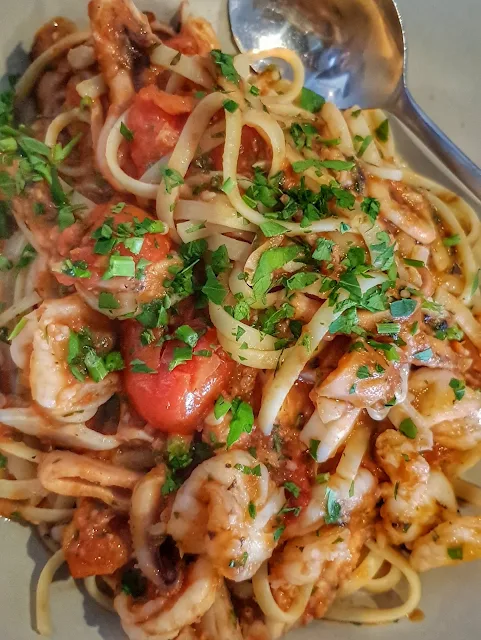The owner's name is Orlando. The restaurant has a family like setting in a light industrial area along an extended Keira Street just maybe ten to 15 minutes stroll south of Wollongong City Centre and its main rail station. Nearby are Delaney's , an institution of a cake shop for the region, a BP station and Europa, a reliable supplier of eastern European groceries that I use.
Is the cooking style from Rome? The popular item is freshly fired pizza, with toppings from Margarita to veg to meat, attracting many take aways and delivery runs. One can see the wood fired stove immediately in front of the entrance. The venue provides some outdoor seating, but the internal tables are often packed at every meal time. Da Orlando is open every day now, after a few years of operations. Vehicle parking is street side, with the restaurant a hub of lit buzz on evenings when the neighbours only open for the day, due to the inherent nature of their businesses.
It is a pleasure to see another culinary outlet do well in a region with not more than perhaps 300,000 people, an area south of Sydney that attracts residential lifestyle whilst the money is made in the Big Smoke up north. Parents may come home from Sydney side and find no time to cook for the family, so off they go to Da Orlando. The menu has remained relatively unchanged all this time, and this can apply even to the black board items. Diners sit snugly with tables of various sizes and the staff has also remained not much changed.
Italian culinary, I believe, is meant to be shared with mates and family. The rich nature of its sauces, its creams and its toppings make it more sensible and a pleasure to partake them communally. You may not want to be stuck with just a huge size pizza unless you are hungry or still growing up fast. Diners do take pizzas here as their mains but i prefer some variety in degustation. I must say the pizzas at Da Orlando are consistently rewarding.
Often when we arrive, Remmie is there, busy with customers or behind the counter. There is also Molly who used to work at uni and is now pursuing a wholesome degree. There is the hard working young man with light hair who usually takes our orders and arranges the wine. The walls of the dining hall are graced with posters and photographs suggesting of the old country.
Favoured entrees are Arancini and Gnocchi. The former offering, literally referring to "little oranges", are filled with a gratifying yummy risotto still warm inside, with the outer skin dark brown and almost crispy. Three are served on a plate for starters. The former are like dew droplets to tease the appetite - they are not my favourite but are served with a sauce that does get us going.
I am always happy with two particular mains at Da Orlando. I have a soft spot for their Linguine Fruits of the Sea, presented with a heady mix of rich tomato sauce, and for a comparatively lighter option, their Penne with chicken pesto.
Both dishes could not be so different, and yet complete a delightful experience.
Wollongong is a town with several Italian restaurants of note.
I like the Pecorino cheesewheel pasta at Cin Cin in Thirroul;
look forward to the pizzas crafted at Pizzeria 50 in downtown Wollongong and Gambino's in Fairy Meadow; and love the scenery looking out from the North Beach Pavilion in North Wollongong Beach. Servings are generous at the Costa Azzurra in Fairy Meadow and there is a community atmosphere at Cucinas along lower Crown Street in down town Wollongong.
So there is much competition and choice for Wollongsiders as far as Italian fare is concerned. Yet at most meal times, Da Orlando is packed with a happy buzz. The quality of their offerings is consistent, the service is quick and you do nicely bump into your mates at the place.My weakness here is for the Calzone packed tightly with Nutella choc spread, again best eaten to be shared with teenagers.
There is a notable absence of meat dishes though, with the menu emphasising pizzas and pasta. So what are my overall impressions of Da Orlando?
Ambiance 8 out of ten
Taste 8 out of ten
Staff Engagement 8.5 out of ten
Culinary Variety 7.5 out of ten
X Factor 8 out of ten
Overall Score 8 out of ten
Da Orlando is located at 348 Keira Street, Wollongong NSW.












